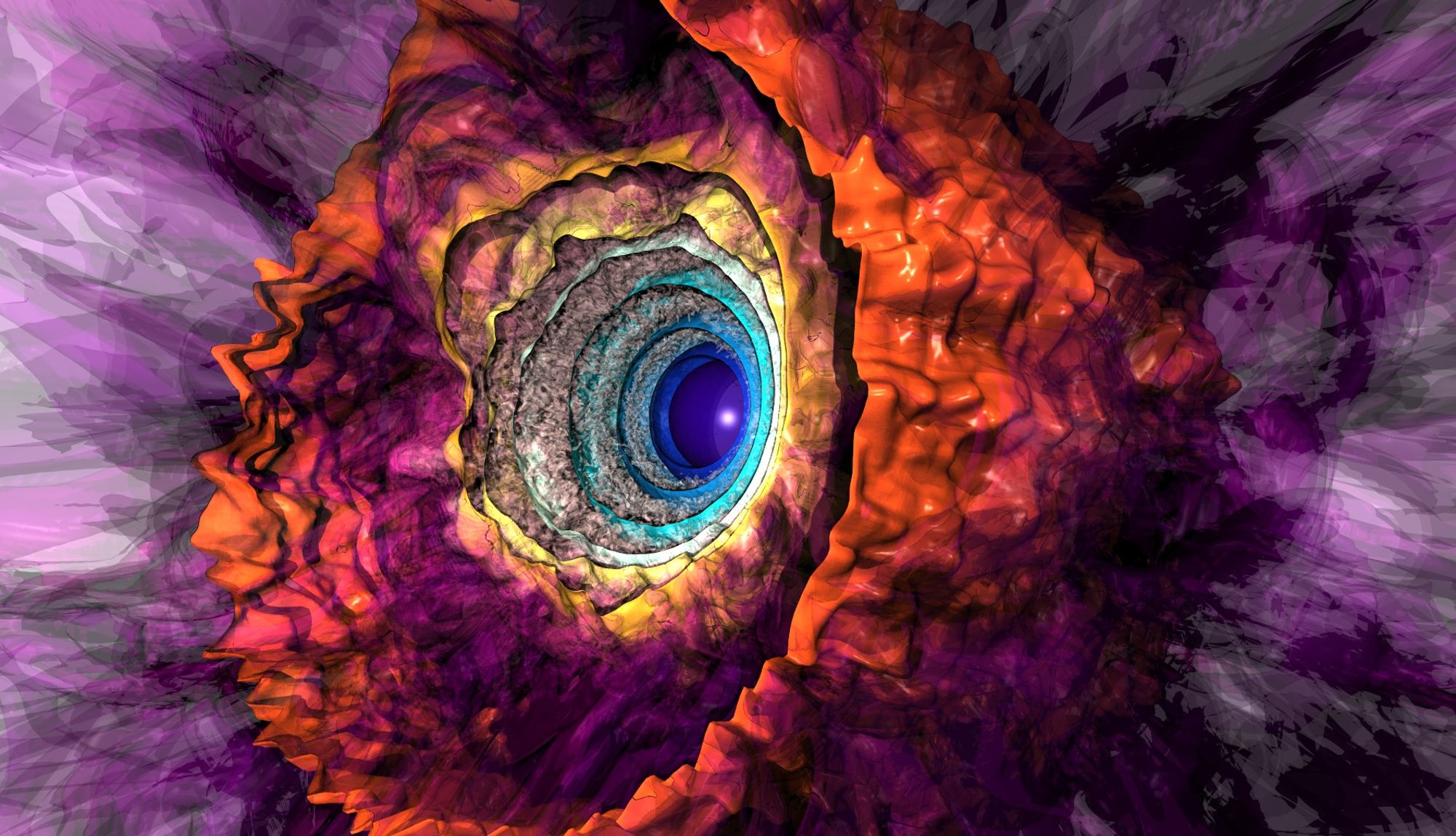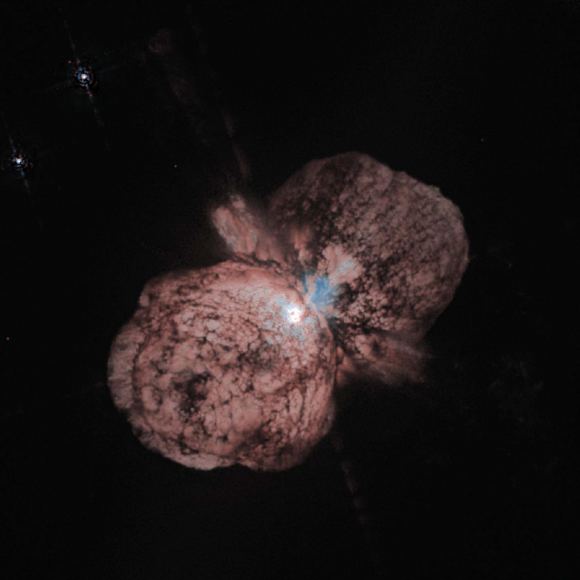Creepy blue giants can reveal the secrets of the evolution of stars
Translation of an article by Paul Sutter (PAUL M. SUTTER) published on Universe Today

Imagine a star millions of times brighter than the sun, which emits a powerful flash every several decades, comparable in brightness to a supernova explosion. And with all the enormity of such explosions, they do not destroy our restless star. The star continues to live its life, its surface beats in violent convulsions, the source of which are the inner layers. Soon the colossal explosion will end the star's suffering, but until then, for thousands of years, it will have to endure such an existence.
We are talking about rare bright blue variable stars, which can contain clues to understanding the connection between the life of stars and their death.
Bright blue variables (LBV) stars are incredibly rare objects. At the moment, astronomers are aware of the existence of only about 20 (this is not accurate) of such objects, and it is believed that in our galaxy there can be a maximum of a few hundred. Because they are so rare, we don’t understand them well. Due to the fact that we understand them poorly, they are difficult to describe.

The homunculus nebula formed after the grand explosion of the Eta Carina LBV (Eta Carinae). Jon Morse (University of Colorado) & NASA Hubble Space Telescope
Here is what we know:
But what we do not know about them:
Everything else.
Probably the biggest mystery of the LBV stars lies in their diabolical instability. What exactly causes infrequent, but fantastic in scale flashes? Although it is difficult to immediately answer this question (one must think, because these stars are incredibly complex physical systems), scientists believe that the key lies in the complex connection between the outer and inner layers of such stars.
LBV stars suffer the most severe form of irritable bowel syndrome you can imagine. Their insides are constantly turned out by colossal convection currents that carry hot matter from the core to the surface, and the cooled from the surface to the core. This is a completely normal process for ordinary stars, but for LBV stars here it just breaks the bar - convection currents actively push the clots of the outer layers much higher and further than usual.
A little separated due to convection from the body of a hot star, the outer layers can finally cool down a bit. This increases their density, which in turn blocks the stellar light coming from below. The radiation pushes (like a solar sail, only at times more serious) this compacted outer layer, completely tearing it away from the star, and accompanying all this with a powerful flash of light and ejection of matter.
In this story, much remains to be clarified and answered one important question: the LBV stage of massive stars, accompanied by violent seizures, is not a precursor to the even more insane stage of evolution of stars known as the Wolf-Rayet phase, or after LBV does supernova arise?
If we had at our disposal several hundred thousand years to observe the life and death of such stars, this question could be easily answered. But we don’t have that time, so it’s hard to find the answer.
One of the clues lies in the relationship between the giant stars. If the course of life of the most massive stars in the Universe looks like this - “giant / bright blue variable / Wolf-Rayet / broads”, plus each of the stages is relatively transient, then we should observe all these stages in our stellar environment. Big stars are born together, grow old together and die together.
But if the LBV stars themselves and go to the last "broads" a separate path, then they should be different from their relatives - the Wolf-Rayet stars. Figuratively speaking, they will be settled in a separate nursing home, at the other end of the city.
The best place to find such kinship is the Large Magellanic Cloud, as it is a relatively isolated object in the night sky.
Studies of the issue of the massiveness of LBV stars with varying success have been conducted over the past few years, while scientists are trying to come to a unified definition of the concepts of “massiveness” and “LBV”.
Fresh researchrecently adopted for publication in the Astrophysical Journal, clarifies the “standard” (as far as possible in such cases) description of the LBV: this is one of the many monstrous stages in the life of massive stars before their death. This means that if we understand how LBV stars are arranged, we will understand how giant stars die.

Imagine a star millions of times brighter than the sun, which emits a powerful flash every several decades, comparable in brightness to a supernova explosion. And with all the enormity of such explosions, they do not destroy our restless star. The star continues to live its life, its surface beats in violent convulsions, the source of which are the inner layers. Soon the colossal explosion will end the star's suffering, but until then, for thousands of years, it will have to endure such an existence.
We are talking about rare bright blue variable stars, which can contain clues to understanding the connection between the life of stars and their death.
Blue period
Bright blue variables (LBV) stars are incredibly rare objects. At the moment, astronomers are aware of the existence of only about 20 (this is not accurate) of such objects, and it is believed that in our galaxy there can be a maximum of a few hundred. Because they are so rare, we don’t understand them well. Due to the fact that we understand them poorly, they are difficult to describe.

The homunculus nebula formed after the grand explosion of the Eta Carina LBV (Eta Carinae). Jon Morse (University of Colorado) & NASA Hubble Space Telescope
Here is what we know:
- These are big stars. Very big. The smallest of them can be compared in mass with our ten suns, and the largest - with hundreds. But even the smallest of them in their youth were much, much more, and decreased to the size that we are seeing now, after a series of monstrous explosions that have blown their own atmosphere into outer space.
- These are bright stars. Their luminosity exceeds solar 250,000 times and can reach values exceeding the luminosity of the sun 3 million times. So the temperature of their surface should be from 10 000 K to 25 000 K, which is several times hotter than the sun.
- The rarity of such stars is probably related to their fragility. Many of the most massive ordinary stars, and possibly * all * big stars, go through the LBV phase. It is precisely at the end of their lives, right before becoming a supernova, that they go through the LBV stage in less than a hundred thousand years. This is such a short period of time that there can be only a few hundred such objects in an average galaxy at a time.
- They are spontaneous, violent and unstable. One of the first LBV stars discovered, Eta Carinae (Eta Carinae), was the second brightest object in the sky ... only three days in March 1843. It is no longer visible to the naked eye.
But what we do not know about them:
Everything else.
Warm up before the final
Probably the biggest mystery of the LBV stars lies in their diabolical instability. What exactly causes infrequent, but fantastic in scale flashes? Although it is difficult to immediately answer this question (one must think, because these stars are incredibly complex physical systems), scientists believe that the key lies in the complex connection between the outer and inner layers of such stars.
LBV stars suffer the most severe form of irritable bowel syndrome you can imagine. Their insides are constantly turned out by colossal convection currents that carry hot matter from the core to the surface, and the cooled from the surface to the core. This is a completely normal process for ordinary stars, but for LBV stars here it just breaks the bar - convection currents actively push the clots of the outer layers much higher and further than usual.
A little separated due to convection from the body of a hot star, the outer layers can finally cool down a bit. This increases their density, which in turn blocks the stellar light coming from below. The radiation pushes (like a solar sail, only at times more serious) this compacted outer layer, completely tearing it away from the star, and accompanying all this with a powerful flash of light and ejection of matter.
In this story, much remains to be clarified and answered one important question: the LBV stage of massive stars, accompanied by violent seizures, is not a precursor to the even more insane stage of evolution of stars known as the Wolf-Rayet phase, or after LBV does supernova arise?
Relatives of the Giants
If we had at our disposal several hundred thousand years to observe the life and death of such stars, this question could be easily answered. But we don’t have that time, so it’s hard to find the answer.
One of the clues lies in the relationship between the giant stars. If the course of life of the most massive stars in the Universe looks like this - “giant / bright blue variable / Wolf-Rayet / broads”, plus each of the stages is relatively transient, then we should observe all these stages in our stellar environment. Big stars are born together, grow old together and die together.
But if the LBV stars themselves and go to the last "broads" a separate path, then they should be different from their relatives - the Wolf-Rayet stars. Figuratively speaking, they will be settled in a separate nursing home, at the other end of the city.
The best place to find such kinship is the Large Magellanic Cloud, as it is a relatively isolated object in the night sky.
Studies of the issue of the massiveness of LBV stars with varying success have been conducted over the past few years, while scientists are trying to come to a unified definition of the concepts of “massiveness” and “LBV”.
Fresh researchrecently adopted for publication in the Astrophysical Journal, clarifies the “standard” (as far as possible in such cases) description of the LBV: this is one of the many monstrous stages in the life of massive stars before their death. This means that if we understand how LBV stars are arranged, we will understand how giant stars die.
